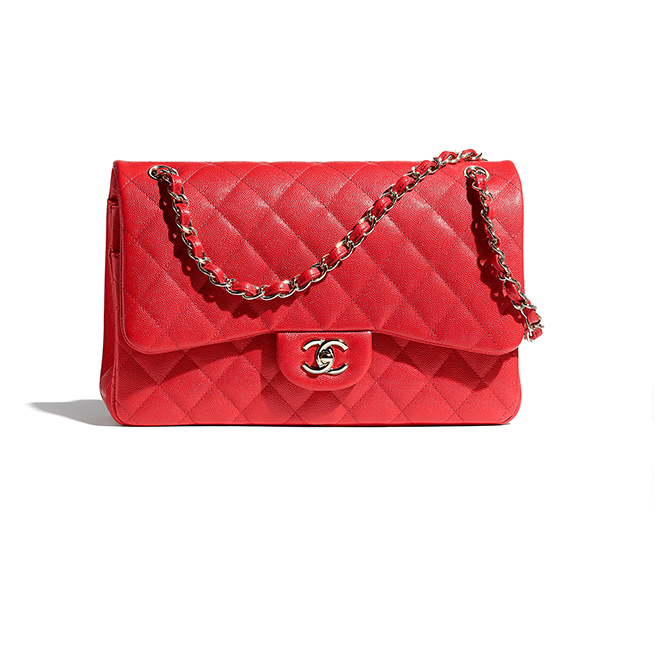Characterised by the double-C clasp, the Chanel 11.12—more commonly known as the Classic Flap bag—has been well-loved ever since Karl Lagerfeld introduced it in the early ‘80s. Fast forward 40 years later, the carrier now takes the throne as one of the most sought-after bags across the globe. And while the brand experiments with different materials and colours each season, one thing that has remained the same is its silhouette.
To celebrate one of fashion’s most iconic bags, below, we delve into the world of 11.12 and explore the “secrets” behind the bag’s popularity:
1. The 11.12 originates from the 2.55 bag
The 11.12 may be Chanel’s most emblematic bag, but its design is actually inspired by its predecessor—the 2.55. Introduced in 1955 by Gabrielle Chanel, the arm candy was created when she realised the need for a handbag that’s both functional yet fashionable.
Mademoiselle Chanel’s decision to craft the bag using lambskin, jersey, and silk—which was deemed unusual and innovative at that time—sets her apart from the typical leather craftsmen. The interior of the 2.55 was made in red grosgrain, and the design is complete with a rectangular clasp, gold chain, and other metallic adornments—reminiscent of her costume jewellery. It wasn’t long before actresses such as Brigitte Bardot, Jeanne Moreau, and Catherine Deneuve snapped them up.

2. Quilting
The diamond-shaped quilting is one of the Maison’s most recognisable details. As seen on the 2.55, the overstitched quilting was introduced as Gabrielle Chanel wanted an authentic design that’s stylish yet stood the test of time. She translated her love for the equestrian world and took cues from the quilted jackets of the stable lads, as well as the horse’s quilted saddle blankets.
3. Leather
Lambskin and calfskin are the two materials that are used to create Chanel’s bags. Gabrielle Chanel revolutionised the industry when she opted for lambskin—traditionally used for gloves and deemed too delicate for handbags—to create the 2.55. Years later, the design is also available in calfskin, and fans of the brand can take their pick between the smooth leather or the caviar grain which gives the bag a pebbled finish.
4. Chain strap
A Chanel bag is never complete without the emblematic strap that features a metal chain interlaced with a black leather ribbon, and the idea of it stemmed from Gabrielle Chanel’s desire for a hands-free bag. “Tired of holding my bags in my hands and losing them, I added a strap and wore them over my shoulder,” she said. The style also enabled her favourite hands-in-the-pocket pose.

5. Carrying
With the introduction of the chain strap, the bag can now be worn in multiple ways. Whether it’s under the arm, held in the hand, worn on the wrist, or slung across the body, the chain allows you to carry it with a single or double chain. The vibe? Nonchalant yet elegant.

6. Pockets
Each 11.12 bag comes with exactly seven pockets, and this is not just a coincidence. Aside from the one in the back that’s shaped like “Mona Lisa’s smile” as nicknamed by the ateliers, there are six other internal pockets that are made for you to store your cards, phone, documents, makeup, and more. Mademoiselle Chanel once said, “if you’re sad, add more lipstick and attack”, and with a special compartment created fo just that, we’re ready for any battles that come our way.
7. Points de bride
The “points de bride” (“bar tack” in English) technique is used to achieve the bag-in-bag design, which gives it a more solid finish. With one mounted to construct the interior and the other for the exterior, two handbags are sewn together and swivelled back into place to become a single piece.
8. Double-C clasp
The biggest difference between the 11.12 and the 2.55 bags? The clasp. The former features a Chanel monogram clasp that’s screwed onto the interior of the flap. Introduced along with the bag, the hardware has been a signature of the Maison since the ‘80s.

9. Double-flap
Aside from the double-C clasp, the Chanel 11.12 also comes with a double flap in diamond-shaped quilting. The first flap opens and closes the bag while the second one protects the privacy of the bag’s contents.
10. “Piqué-retourné”
“Piqué-retourné” refers to the procedure in which the artisans invert the bag after turning them inside out at the start. The process is similar to the creation of the brand’s ready-to-wear pieces.
11. Lining
With an aim to make a practical bag for herself and other women, Gabrielle Chanel opted to line her bags in a bright contrasting hue that would enable wearers to find their personal belongings easily. Throughout the decades, the colour has evolved from raspberry red into burgundy.
12. Iconic
When the late Karl Lagerfeld took over the brand in the 80s, he identified the eternal allure of the 2.55 by introducing the 11.12. Now, as the French fashion house is under the helm of Virginie Viard, the designer has also continued both of her predecessor’s legacies by incorporating them into her collections.
Check out the Spring/Summer 2021 offerings below:








| SHARE THE STORY | |
| Explore More |




